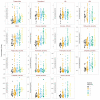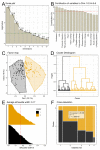Machine Learning Refutes Loss of Smell as a Risk Indicator of Diabetes Mellitus
- PMID: 34768493
- PMCID: PMC8584618
- DOI: 10.3390/jcm10214971
Machine Learning Refutes Loss of Smell as a Risk Indicator of Diabetes Mellitus
Abstract
Because it is associated with central nervous changes, and olfactory dysfunction has been reported with increased prevalence among persons with diabetes, this study addressed the question of whether the risk of developing diabetes in the next 10 years is reflected in olfactory symptoms. In a cross-sectional study, in 164 individuals seeking medical consulting for possible diabetes, olfactory function was evaluated using a standardized clinical test assessing olfactory threshold, odor discrimination, and odor identification. Metabolomics parameters were assessed via blood concentrations. The individual diabetes risk was quantified according to the validated German version of the "FINDRISK" diabetes risk score. Machine learning algorithms trained with metabolomics patterns predicted low or high diabetes risk with a balanced accuracy of 63-75%. Similarly, olfactory subtest results predicted the olfactory dysfunction category with a balanced accuracy of 85-94%, occasionally reaching 100%. However, olfactory subtest results failed to improve the prediction of diabetes risk based on metabolomics data, and metabolomics data did not improve the prediction of the olfactory dysfunction category based on olfactory subtest results. Results of the present study suggest that olfactory function is not a useful predictor of diabetes.
Keywords: data science; diabetes mellitus; human olfaction; machine-learning; patients.
Conflict of interest statement
The authors have declared that no competing interest exist.
Figures






References
-
- Doty R.L. Clinical disorders of olfaction. Handb. Olfaction Gustation. 2015:375–402. doi: 10.1002/9781118971758.ch17. - DOI
LinkOut - more resources
Full Text Sources

